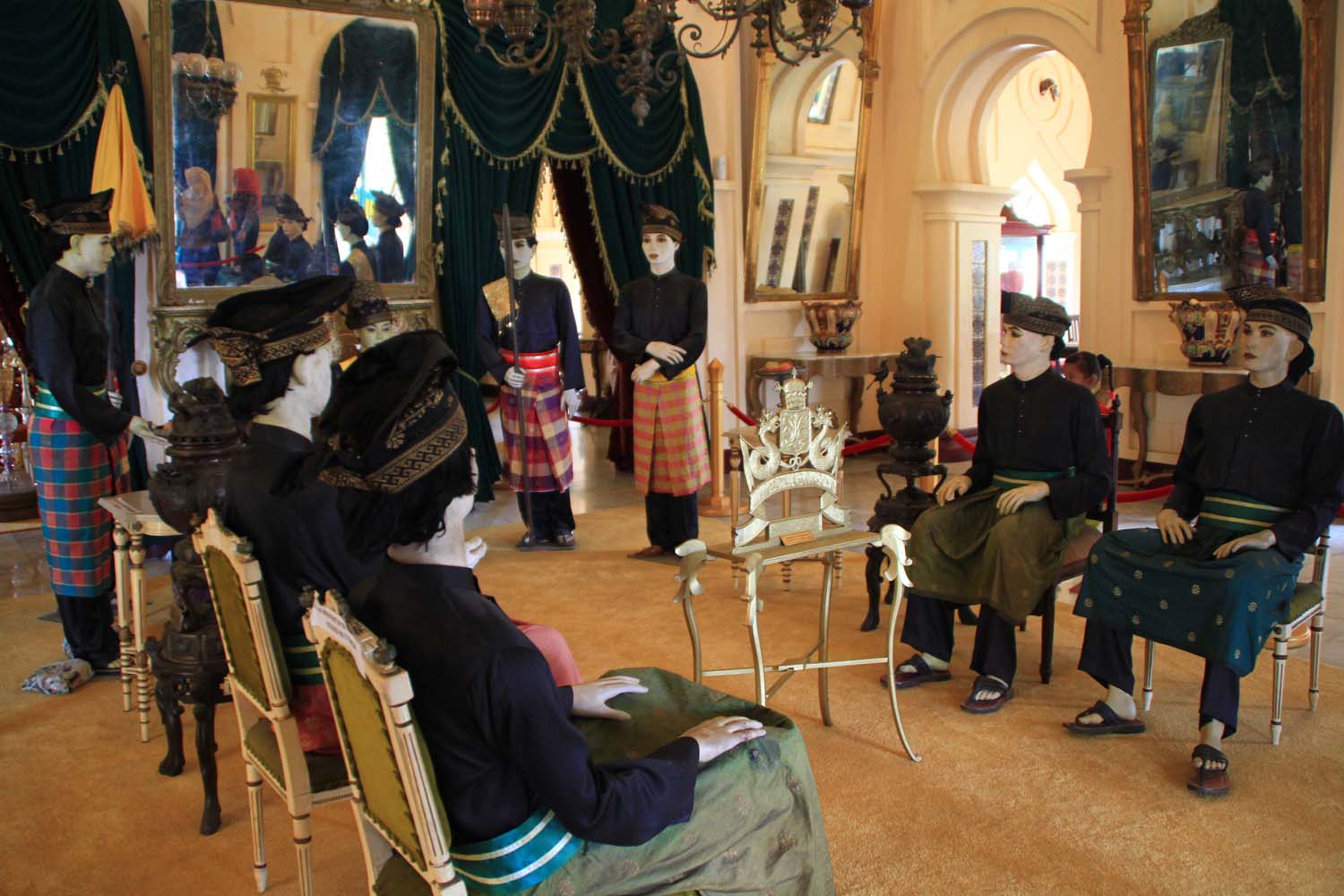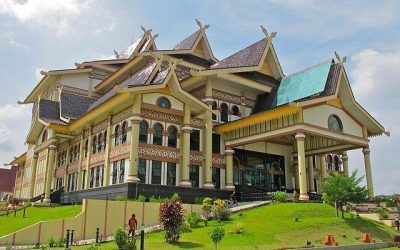Home / Batik Regions – Western Indonesia – Northern Sumatra – Riau / The Sri Indrapura Siak Palace
Cultural Destination
Embrace the spirit of the place!
The Sri Indrapura Siak Palace

The Siak Indrapura Royal Palace (photo: Sinar)

The main hall of Siak Indrapura Royal Palace (photo: Pesona Indonesia)
The Sri Indrapura Siak Palace
Sri Indrapura Siak Kingdom was the largest Islamic Malay kingdom in Riau. The kingdom experienced its glorious period from the 16th to 20th centuries. Founded by Sultan Abdul Jalil Rahmat Syah in 1723 AD, Siak Indrapura palace complex has an area of around 32,000 m² and consists of four palaces. Siak Palace building combines Malay, Middle Eastern, and European architectural styles. Tourists can observe a diverse collection concerning royal objects, ranging from gold-plated throne chairs, royal umbrellas, royal deposit box, duplicate crowns of the king, and even try Riau’s traditional costumes.
Tourist Attractions in Riau
Idrus Tintin Cultural Centre
With a unique Riau-Malay style architecture, Idrus Tintin Art Pavilion is
Riau
Batik Motifs
Tabir Tanjung
Tanjung flower is a type of Cherry tree flower, which is commonly found in
Pucuk Rebung Riau
Pucuk Rebung symbolizes heart determination in achieving goals, good luck, and
Kasih Tak Sampai
‘Kasih Tak Sampai’ is an idiom in the Indonesian language which refers to
Discover
Indonesian
Batik
Motifs
Paqbarre Allo
The word “Barre” means round and “Allo” means the sunlight. This motif is interpreted as
Hiu Taliyasan
Indonesia is also home to the world’s largest fish, the whale shark (Rhincodon typus). Hiu Taliyasan refers to
Honai
The Honai is inspired by the traditional house of the Papuan community living in
Sero Tangga
The Sero Tangga illustrates an endearing feeling and sacrifices of a person to fulfil
Kasih Tak Sampai
‘Kasih Tak Sampai’ is an idiom in the Indonesian language which refers to
Pala Salawaku
This motif illustrates the unique weapons of the Maluku region, namely
Gumin Tambun
Based on Hindu mythology, this motif symbolizes lucks, abundant wealth, and
Pattimura
Pattimura is the name of an Indonesian hero who fought against colonialism in
Keluak Daun Pakis
The word “Keluak” is a Minang language which means twisted or tangled. The Motif of
Dayak Taghol
Dayak Taghol has a distinctive style of four curved lines and small dots. This motif represents
Malinau Cultural Festival
You will witness a unique competition that might not be found other than in
Daun Sirih
This motif illustrates betel leaves that are used by Lombok communities as traditional
Tabir Tanjung
Tanjung flower is a type of Cherry tree flower, which is commonly found in
Teguh Bersatu
This batik motif shows the strength of the people of Kupang. It also represents a sense of
Sekar Jati
Sekar means flower and Jati refers to teak trees that symbolizes a strong mental character that
Durian Pecah
Broken Durian motifs depict the foundation of faith. The second half signifies the mastery of
Gorga Simeol-Meol
The Gorga Simeol-meol is a pattern of plant tendrils. it is regarded as a symbol of longevity and
Kain Cual
Cual textile tradition has existed since the 17th century. The word “Cual” refers to
Gamolan
This motif illustrates Gamolan, a bamboo musical instrument of Lampung that is
Pati-Pati Pinehiku
It symbolizes the hierarchy in society and the social status of the Mekongga
Tikar Natuna
The Tikar Natuna motif is adapted from the traditional making of pandanus mats in
Ukir Sentani
The Ukir motif is a batik motif that is inspired by various traditional Sentani wood carvings
Leuit Sijimat
This motif reflects the daily activities of the Baduy tribe in Banten. The main ornaments of batik motif consist of:
Jumputan Bintang
The word Jumputan means the tie-dye technique, while the word “Bintang” refers to
Besurek Rembulan
This batik illustrates praise for God who created the wonderful universe
Kaharingan
The Kaharingan or ‘tree of life’ based on the Dayak tribes’ belief system. This tree symbolizes
Tifa Totobuang
The batik motifs illustrate Maluku’s traditional music instrument called
Enggang Dayak
Local people beliefs that hornbills are an incarnation of the Commander of the Birds. It has supernatural
Tengkawang Ampiek
With its many advantages, the Dayaks use this leaf in ritual ceremonies. This plant is a symbol of
Kawung
The Kawung motif was created by Sultan Agung Hanyokrokusumo (1593 – 1645) as a symbolic gift for
Angsa Duo
According to legend, the Angso duo batik motif is a pair of swans that are believed to have led Princess
Salakanagara
Salakanagara batik motif illustrates the first kingdom in the Betawi land
Kerawang Tegak Aceh
The Vertical Upright (Kerawang Tegak) Motif symbolizes a person who has a strong
Besurek Rafflesia
The term “Basurek” refers to a textile that contains letters or inscriptions
Ikan tambal
The word “Ikan” refers to fish. The philosophical meaning of Ikan Tambal means is
Karawo Pinang
Pinang refers to the Palm areca tree. This motif is considered as the original
Gajah Way Kambas
The motif illustrates the Lampung’s natural reserve, the Way Kambas. it also symbolizes
Daun Simpor
This motif is inspired by the Simpor plant (Dillenia Suffruticosa) which is a typical
Tubo Kelapa
Coconut tree is a symbol of a good character and strong mentality. It illustrates the more success a person, the more
Rangkiang
The word “Rangkiang” refers to the rice granary in the Minangkabau language. It symbolizes
Lipaq Sabe
Lipaq Saqbe contains a simple geometric classical motif with various flower decorations. This textile is
Pucuk Rebung Riau
Pucuk Rebung symbolizes heart determination in achieving goals, good luck, and
Awan Berarak
Awan Berarak is a combination of Dayak motifs and Malay patterns. The word ‘Awan Berarak’ means the
Bekantan Pakis
This motif represents Pakis Haji (Polystichum setiferum), an endemic plant in
Taiganja
Taiganja is a precious gold pendant that shows the social status of the Kaili family. It is
Kaganga Tanah Rejang
If Batik Besurek combines Arabic calligraphy motifs, then the Kaganga batik takes
Parang Rusak
Another meaning behind this motif is an unconquerable spirit, symbolized by
Singayaksa
The Singayaksa motif comes from the name of a place where Sultan Hasanuddin used to
Gonggong Beruntun
This motif illustrates that a person should maintain a positive attitude and
Rumah Mamuju
the Batik motif illustrates the house of Mamuju King with the stairs, located on the left of the wooden stage house
Karawo Mahkuta
Mahkuta refers to Gorontalo’s traditional crown. It represents noble characters of
Pinawetengan
The Pinawetengan Batik pattern was taken from a prehistoric inscription in
Srimanganti
The name of the Srimanganti motif is derived from Palace’s hallway that connects to
Parang Seling
Parang Seling or “alternating daggers” is a royal batik motif. It is a feminine variant of
Lontara
The Lontara script itself is a typical ancient script of Bugis and Makassar communities. History records that
Gigi Haruan Lidi
The Gigi Haruan Lidi motif is taken from the name of the cork fish and is a symbol of
Bultiya
The word ‘Bultiya’ is an acronym of the three major tribes in North Kalimantan, namely
Gurdo Solo
Gurdo or garuda bird is the mount of the Indian god Vishnu. As the Sun Bird,
Manguni Minahasa
Manguni is identified as the symbol of the Minahasa people. Manguni is known as a
Gedhog Kembang Waluh
a combination of Javanese cultural motif of the Majapahit kingdom (XII-XIV century) with
Jupri Kembang Teh
Kembang Teh illustrates the tendrils of tea plants that grow in the highlands of
Kuda Kupang
Horses symbolize wealth. It contains noble values of virtuous characters that bring
Gonggong Siput
Gonggong (Strombus Turturella) is one type of sea snail found around
Desa Na Tolu
The Desa Na Tolu characteristic pattern symbolizes the Batak philosophy of existence and
Tongkonan
Toraja’s traditional house is called Tongkonan. Tongkonan is a place for
La Galigo
La Galigo is a literary work of the Buginese Epic that has 300 thousand epic lines. It is considered even
Tenun Bima
The motifs are adopted from Bima woven textile. This pattern has received a great
Sekomandi
Its philosophical meaning is the eternal union which refers to a saying “until death do us part”
Prada Papua
The word “Prada” in the Javanese-Indonesian dialect means a batik textile that
Merak Ngeram
The hatching peacock motif has a very deep meaning which refers to the sacrifice and
Wakatobi
It symbolizes the coastal beauty of the Wakatobi island and the symbol of Patra symbolizes
Bomba Mawar
This motif means sacred love for family, kingdom, and God; It also illustrates
Raja Ampat
Raja Ampat motif represents the marine life at Raja Ampat archipelago in
Wirasat
Wirasat or divine inspiration is a gift from God. This inspiration is symbolized by
Sandeq
Sandeq Boat is a symbol of the maritime importance of the West Sulawesi region. The greatness of

